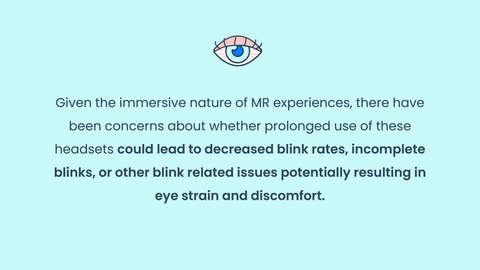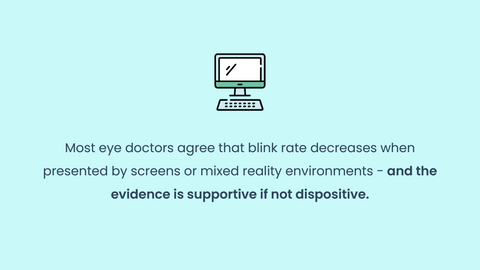Mixed reality headsets, such as Meta’s Oculus or Apple’s Vision Pro, promise a more immersive experience with great digital fidelity. But, the evidence is starting to suggest that they also may cause a lower than normal blink rate.
Multiple studies have shown this lower blink rate - including the 2022 Kim study (https://www.mdpi.com/1660-4601/19/14/8551). Low blink rates for commonly used equipment can lead to ocular surface disease, particularly dry eye. Generally, many papers and researchers have established that more screen time increases one’s chance to develop ocular surface disease.
The biggest challenge with the current mixed reality headset research is that it is typically time bound on very small scales - like 1 minute of observation for each participant with fewer than 20 participants. Fundamentally, many of the challenges of dry eye and ocular surface disease are tied to the gradual progression over long time windows. It would be comparable to having a person drink a can of Coca-Cola and then observe that no cavity formed within one minute. We know that sugar on the teeth without mitigation will eventually lead to decay, but we don’t know exactly when or with what type of frequency.
We also know that individuals react differently to different stimuli. Thus, sample sizes, ages, and frequency of use also need to be evaluated.
Like the effect of drinking soda on teeth, we do know that not blinking or blinking less frequently has negative long-term consequences. Multiple studies illustrate that low blink rates lead to dry eye disease. (https://www.reviewofophthalmology.com/article/a-patients-view-of-dry-eye-disease)
Dry eye disease has increased dramatically since the advent of the smart phone (10x change). While this could be correlated and not caused by the smart phone, the combination of research and environmental observation strongly suggests that screen time is causing the dramatic shift in dry eye disease. There simply is not a definitive paper that is willing to make that assertion…yet.
Blinking is a vital physiological function that helps keep our eyes lubricated and protects them from dryness and irritation.

The evidence on this topic, however, is not conclusive, but is suggestive. A study often cited in discussions about blink rate and MR headsets involved a small sample size of only 17 participants engaged in a first-person shooter game scenario. This study found no significant decrease in blink rate compared to baseline measurements. However, the limitations of small sample sizes and specific gaming contexts raise questions about the generalizability of these findings. In particular, it was noteworthy that the game involved shooting - which has a high percentage likelihood of causing someone to blink (as described by the authors). (https://journals.pan.pl/dlibra/publication/126018/edition/109949/content)
On the other hand, alternative research endeavors have provided a different perspective. A study published in the journal "Processes" explored the impact of MR headsets on blink rate and eye strain. Contrary to the aforementioned study, this research indicated lower-than-normal blink rates among participants using MR headsets. Furthermore, it highlighted the potential for increased eye strain and computer vision syndrome associated with prolonged MR headset use. https://www.mdpi.com/2073-8994/10/9/400
Another study published in the International Journal of Environmental Research and Public Health echoed similar concerns, suggesting that MR headset users may experience lower blink rates and heightened discomfort compared to traditional screen-based interactions. This study appears to be the most robust in that it evaluated four different states - normal, in front of a computer screen, in a mixed reality headset, and with an AR headset. The decrease in blinking was noted across each of the four steps observed. But, there were only 21 participants. (https://www.ncbi.nlm.nih.gov/pmc/articles/PMC9324030/)
The conflicting findings underscore the complexity of assessing the impact of MR technology on human physiology and behavior. Factors such as immersion level, content type, duration of use, and individual differences in susceptibility to eye strain play crucial roles in shaping the outcomes of these studies.

Future studies should aim for larger sample sizes, diverse participant demographics, and a broader range of MR applications to capture a more comprehensive understanding of its effects.
In the meantime, users of MR headsets can take proactive measures to mitigate potential risks. Implementing regular breaks, practicing proper eye hygiene, and adjusting display settings to optimize comfort can help minimize discomfort and maintain eye health during MR experiences.
Ultimately, while the evidence regarding blink rate and MR headsets may be mixed, it serves as a reminder of the importance of balancing technological innovation with human well-being. By staying vigilant and informed, we can harness the transformative potential of MR technology while safeguarding our most precious sensory organ – the eyes.

